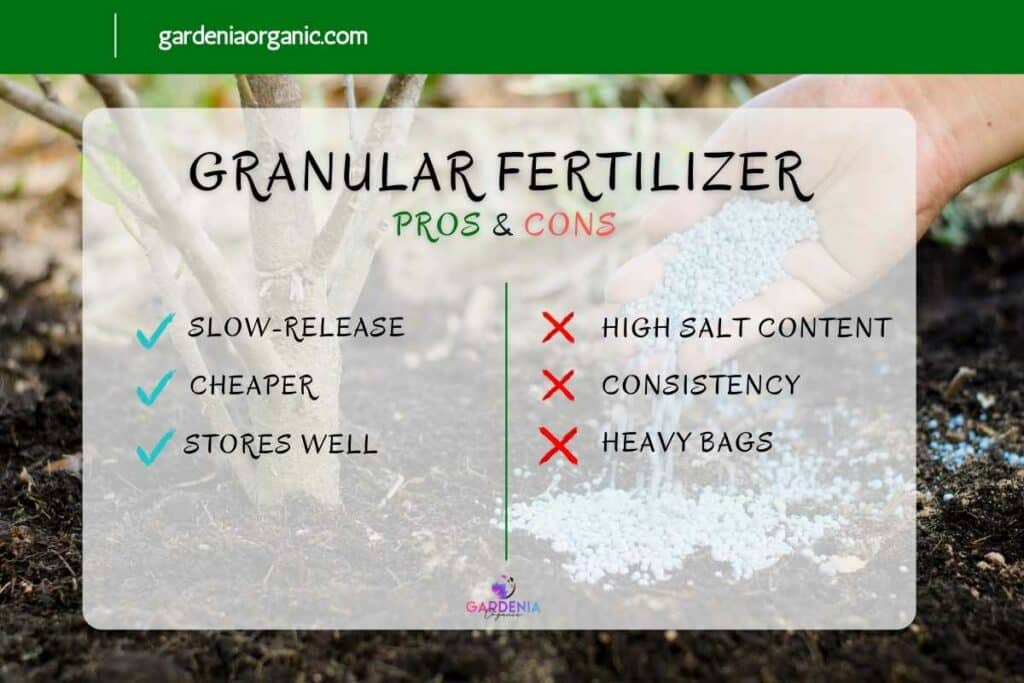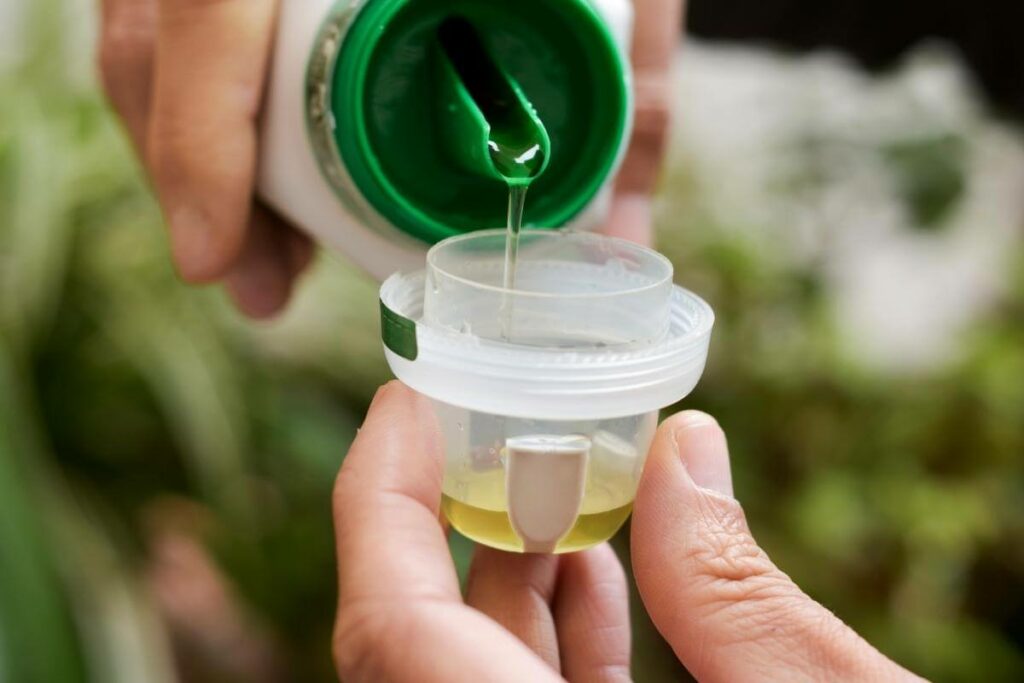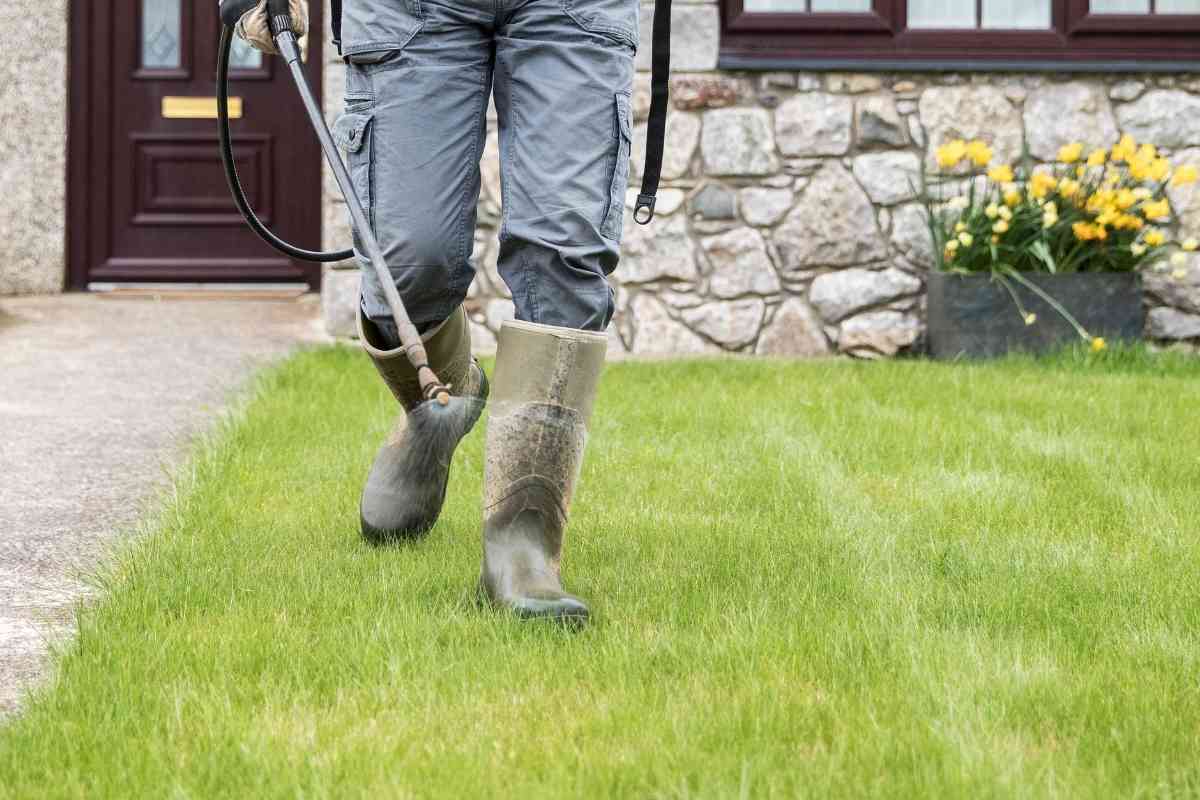For something that seems to grow everywhere, grass sure is fussy on what conditions it will grow under.
Too much sun, not enough sun, the right soil composition, watering, and now fertilizer?
There are so many choices it might be hard to decide which is better for lawns; granular or liquid fertilizer?
When applied correctly, and when needed, both are good for your lawn, but liquid fertilizers have more benefits and are easier to use than granular fertilizers. Below you’ll find a complete guide on the advantages and disadvantages of both.
What’s the Difference?
Before we can decide which fertilizer is better, you need to know the difference between the two, and what fertilizer is.
Put simply, fertilizer is plant food.
There are three key nutrients in fertilizer:
- nitrogen
- phosphorus
- potassium
These make up the N-P-K analysis where you can see the ratio of each nutrient.
Nitrogen is the nutrient that is going to make your lawn look fuller and greener. It’s important to have a higher N value than the others for your lawn.
Phosphorus is what helps your lawn develop a strong root system. This is also the nutrient that helps flowering plants.
Potassium (the K in N-P-K) fights diseases and keeps the cells in the grass healthy.
And now the difference between the fertilizers.
These are the top four differences between granular fertilizer and liquid fertilizer.
You’ll see how each of these affects our decision on which is better for your lawn.
| Granular Fertilizer | Liquid Fertilizer | |
|---|---|---|
| Rate of Absorption | Slow-release fertilizer that needs to be applied less frequently | Quick-release fertilizer that needs to be applied more frequently |
| Salt Content | Higher salt content that can cause root burn | Lower and diluted salt content to avoid root burn |
| Cost | Cheaper than liquid fertilizers, especially when bought in bulk | More expensive than granular fertilizers. |
| How to Apply | Broadcast or drop spreader | Attach container to garden hose |
Granular Fertilizer
Granular fertilizer has become more of a hybrid recently.
Some types of granular fertilizer are coming with a liquid fertilizer coating for an immediate release of nutrients.

To emphasis the difference between granular fertilizer and liquid fertilizer, this article will compare the difference between regular granular fertilizer, and not the hybrid version.
Benefits
Slow-release may not sound beneficial when you’re talking about giving your lawn nutrients, so why is it being sold?
There are many benefits to using granular fertilizer on your lawn:
- Slow-release formula: This isn’t necessarily a disadvantage for granular fertilizer. Applying granular fertilizer means you won’t have to fertilize your lawn nearly as often as you would with liquid fertilizer.
- Cheaper: Granular fertilizer is cheaper than liquid fertilizer, especially when it is bought in bulk. You won’t have to buy granular fertilizer as often because you’ll be applying it less frequently too!
- Stores well: Granular fertilizer is easy to store. Seal it, keep it dry, and keep it away from heat sources and direct sunlight, and it will keep until you run out.
Disadvantages
There are a few disadvantages to using granular fertilizer:
- High salt content: Granular fertilizer has a high salt content. If the fertilizer is applied too liberally in one area, the salt can dry out the roots and lessen their ability to absorb nutrients. This is referred to as root burn.
- Consistency: Individual granules aren’t a mix of nutrients, but rather each granule is either nitrogen, phosphorus, or potassium. They are often differentiated by colour, but unless you plan on sorting them by colour and spacing out each individual granule evenly, no two areas of your lawn will receive the same amount of each nutrient.
- Heavy bags: Buying granular fertilizer makes it much cheaper than liquid fertilizer, but the bags may be heavy to lift and store.
- Slow-release: This is usually a major benefit for granular fertilizer, but if your lawn is in desperate need of fertilizing, it may be too late for granular fertilizer to make a difference.

How To Apply It
The easiest way to fertilize a lawn with granular fertilizer is to use a broadcast or drop spreader:
- The broadcast spreader flings fertilizer in all directions as you push the machine forward, and the faster you walk, the faster the granules will be shot out. This is great for covering large areas of your lawn.
- The drop spreader drops fertilizer in a straight line between the wheels. Fertilizer will drop at a constant rate, so keeping the same speed is important so you don’t end up with a pile in one spot and a thin layer in others. The drop spreader is great for areas that need more precision like along a sidewalk or driveway.
Water your lawn right after applying the fertilizer.
A good watering will wash the granule fertilizer from the blades of grass, and leave it on the soil where the roots can absorb the nutrients.
Is It Pet Safe?
Always read the label for the manufacturer’s details on how long to wait before your pets can safely go outside on your lawn.
The general rule of thumb is to wait 24 hours after fertilizing your lawn to let your pets in that area.
Liquid Fertilizer

Benefits
- Easy to apply: Liquid fertilizer is easy to apply to your lawn. It’s as easy as attaching the bottle to a hose and watering the grass.
- Buy what you need: You don’t need to buy large bags of heavy fertilizer. Instead, look at the packaging to see how much space it will cover, and buy a bottle that will do your lawn.
- Easy to modify: If your lawn needs more nitrogen, it’s easy to add more into the bottle before spraying your lawn. These changes will give your lawn exactly what they need to grow fuller.
- Even distribution: The nutrients are already blended in the liquid, and then mixed with water for even coverage of your lawn. No area will receive more of one nutrient than another. Because this fertilizer is a liquid, it will cover all areas of your lawn and no spots will be missed.
- Less salt content: Not only is there less salt content to avoid root burn but the salt content is being diluted in the water making it less potent than granule fertilizer.
Disadvantages
There are a lot of advantages to using liquid fertilizer, but there are a few disadvantages to go along with them.
- More expensive: Liquid fertilizer costs more per application than granular fertilizer, and you need to apply it more often.
- Volatilization: Storing liquid fertilizer for long periods leads to a loss of product through evaporation. This will lead to an increase in cost for having to replace the product, but you should also air out the area where the fertilizer was being stored.

How To Apply It
The biggest benefit of using liquid fertilizer on your lawn is how easy it is to apply:
- Attach the bottle to the spray end of your garden hose, and follow the directions to open the bottle so the nutrients can mix with water.
- Start at the farthest end of your lawn and walk backwards while spraying. This stops you from walking through the fertilizer.
This should be done every 6-8 weeks.
The first fertilizing should be done in the early spring, the next one in late spring, then late summer and late fall.
The last fertilizing should be done before frost sets in, otherwise, the liquid nutrients can become damaged as they crystallize in the cold.
You’ve already watered your lawn while applying the fertilizer. Do not water your lawn again until your lawn has fully dried.
What to Avoid: If you water too soon after applying the fertilizer you will dilute it and make the fertilizer not as effective.
Is It Pet Safe?
There are lots of liquid fertilizers that advertise being pet safe, and you won’t have to wait before letting your pet on your lawn.
If the liquid fertilizer doesn’t advertise being pet safe, you can let your pets back out after the grass looks visibly dry. This usually only takes 3 to 4 hours.
Verdict
Between the two, liquid fertilizers are better for lawns.
They are generally better for plant growth, pet safety, and are an easy way for people to fertilize their lawns.
The biggest disadvantage to using liquid fertilizers over granular fertilizers is the cost, but after paying for a broadcast or drop spreader, liquid fertilizers work out to be cheaper.
